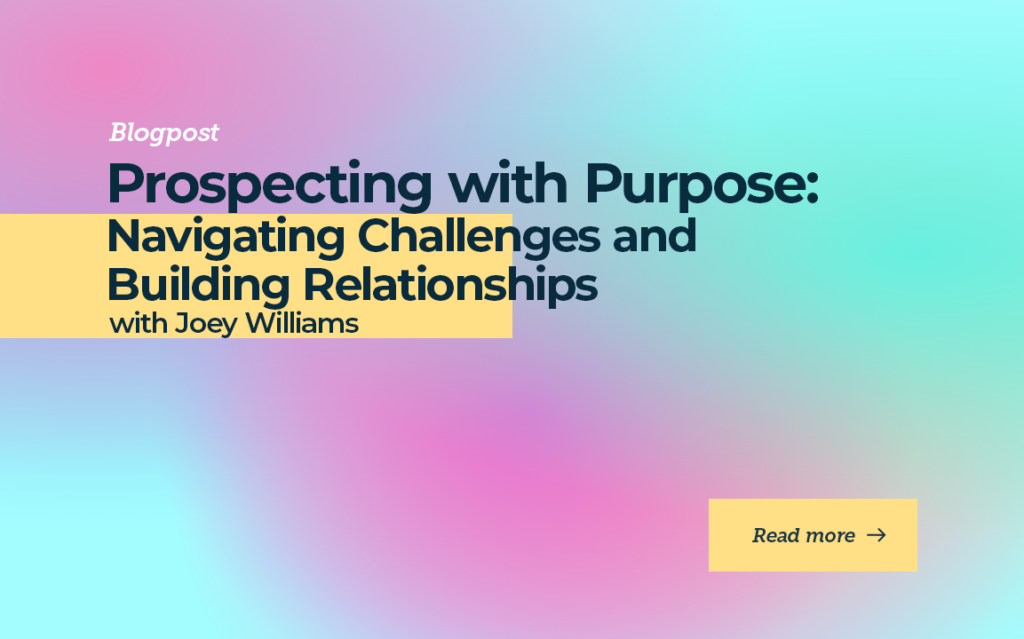Navigating Challenges and Building Relationships with Joey Williams

Joey Williams is the Director of Sales Development at Chili Piper, an inbound lead conversion and scheduling app. Joey joined the Predictable Revenue podcast to discuss prospecting with purpose and how to improve your sales development process.
The value of persistence in an SDR
Joey told the story of his favorite meeting he’d ever booked–one he shares with all new SDRs at Chili Piper.
The prospect agreed to a meeting three months in the future, and Joey took the initiative to follow up the next day, asking if they could move the meeting up. The prospect was furious and canceled the meeting.
Months later, Joey emailed the same prospect to apologize. He admitted he’d been new to sales development at the time and that he’d made a mistake by pushing too hard. Although the prospect didn’t respond, Joey continued to follow up every few weeks.
Finally, the day before the scheduled meeting, the prospect responded. The meeting was a success and that prospect went on to become a customer. Joey shares this story as an example of how persistence pays off.
The SDR role is monotonous and very often filled with rejection. Sometimes it takes more than 10 touches to get a prospect on the phone; it’s essential to stay persistent and put in the work consistently every day to see positive results.
Rejection is part of the job in sales development, but it’s how you deal with that rejection that defines how successful you’ll be in the role.
It’s a sprint, not a marathon
Here are a few tips we like to give our SDRs to keep them in the game:
- Consistency is key for success.
- Always ask for the next step once you get the prospect on the phone/email.
- Always ask for at least one more question when faced with an objection.
- Understand the minimum required you need to get done everyday for success.
- Burn out is your worst enemy – so keep it steady and pick a speed you can maintain for as long as you’re in the role.
Sales development tactics every rep needs to know
The most important trait for an SDR to have is an internal drive to succeed. Sales reps need to be highly motivated, creative, and adaptable.
For sales development leaders, Joey stresses the importance of making good hires early on. Hire the right people, and they’ll set a strong example as you continue to grow your SDR team.
Great sales reps know that success is context-dependent. Copying and pasting a template isn’t enough–they need to perform research and take a tailored approach to each prospect. Taking the time to personalize your email outreach can boost response rates by 10%.

Why SDRs need to have control over who they’re targeting
At Chili Piper, sales management assigns accounts to their SDR team every quarter, but those accounts make up less than half of their total prospects.
Great SDRs don’t rely on an accounts list. Joey’s team is encouraged to take the initiative and find their own prospects through the research process. The result is much more targeted and relevant prospecting.
How Rules of Engagement (ROE) affect the prospecting process
Every organization is different, but Joey recommends all sales development teams set ground rules for when an SDR is allowed or not allowed to work an account. At Chili Piper, the rule is that if no one else on the team has reached out in the last 30 days, that account is fair game.
Tips for more effective research
Your email outreach will be much more effective if prospects feel like you have a reason for contacting them. The ultimate goal for any sales representative is to find unmet needs, for which you need to develop a deep understanding and empathy for your prospect.
Defining and understanding your prospect can vary depending on your industry, product, etc; but a good way to get a full grasp is to understand their core unmeet needs, the context behind those needs, how your team and product/service is positioned to help solve them, and how your solution compares to others in the market.
How to turn your research into personalized outreach
Investing time in personalizing your cold call scripts and/or cold emails is a trade of efficiency; you’ll send fewer (more effective) emails, and you’ll convert a larger number.
Look for ways to make your outreach as relevant as possible. If someone posts about the problem your product solves, that gives you a touchpoint to mention in your outreach. Likewise, if the prospect is following your company on LinkedIn, mention that in your email.
Other triggers include being active on LinkedIn in general (for LinkedIn prospecting), promotions, and following other relevant companies. If a prospect engages with a competitor, that indicates they’re interested in solving that problem.
Lastly, remember that just because you researched something doesn’t mean you need to include it in the email. If where the prospect went to school isn’t relevant, don’t mention it.
Common prospecting mistakes
Once you’ve sent your initial email outreach, don’t let that touch go to waste. Too many SDRs let the prospecting process end after they put someone into a cadence.
Instead, look for ways to create a prospecting experience. One way to do this is through multichannel outreach. After you email, call and leave a voicemail, then send a LinkedIn message. Weave your outreach together.
Ask yourself, “How can I book a meeting with this person right now?”. Be consistent and strategic, and don’t be afraid to get creative.
If a prospect responds, that should automatically trigger more research. For example, if someone responds saying they’re not the right person, don’t ask them who is–go out and find that information yourself. Then you can ask for an introduction to that person specifically.
How to follow up effectively
Before you follow up with a prospect, make sure you have a reason to justify reaching out again. Look for ways to add something valuable to the conversation, even if that value just makes the prospect laugh.
One technique Joey has used in the past is to send a booking link with specific times available and no context. Then, if the prospect doesn’t book a meeting, you can follow up with a quick note saying, “I forgot to mention, if you don’t see a time that works for you on the first page, just click ‘view full calendar’ for more options.”
Good tactics for follow-up via email
- Reminder – a short, sweet email to get back to the top of their inbox.
- New wording – a short email where you rephrase the CTA or benefit from your first email.
- Break up – telling the prospect this is the last they’ll ever hear from you.
- Check back – asking for permission to check back next quarter.
OR
- Change the value prop – a similar format to your first email, but you try a different value prop.
- Be helpful – an email where you share or offer to share a helpful piece of content.
- Use humor – a light email that ends with humor; use sparingly.

The importance of regular SDR training
There is no one-size-fits-all approach to prospecting. That’s why Joey meets with his SDR team every week to look at the meetings that have been booked and reverse-engineer everything the SDR did to book that meeting.
The purpose of this is to remind the team that it wasn’t just one step in the process; it was a combination of factors and techniques that led to the SDR being successful.
If you want to connect with Joey to learn more about prospecting with purpose, reach out on LinkedIn.
Need help coaching your SDR team to book more meetings? Reach out here to learn how we can help.
NO TIME TO READ?
Listen On:



